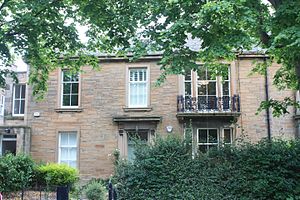James Burgess (archaeologist)
James Burgess CIE FRSE FRGS MRAS LLD (14 August 1832[1] – 3 October 1916), was the founder of The Indian Antiquary in 1872[2] and an important archaeologist of India in the 19th century.[3]
Life[edit]
Burgess was born on 14 August 1832 in Kirkmahoe, Dumfriesshire. He was educated at Dumfries and then the University of Glasgow and the University of Edinburgh.[4]
He did educational work in Calcutta, 1856 and Bombay, 1861, and was Secretary of the Bombay Geographical Society 1868-73. He was Head of the Archaeological Survey, Western India, 1873, and of South India, 1881. From 1886-89 he was Director General, Archaeological Survey of India.[1]
In 1881 the University of Edinburgh awarded him an honorary Doctor of Letters (LLD).[5]
He retired to Edinburgh around 1892.
He was elected a Fellow of the Royal Society of Edinburgh in 1894. He won its Keith Medal for 1897-99, and served as their Vice President 1908 to 1914.[5]
He died on 3 October 1916, at 22 Seton Place in Edinburgh.[4]
Selected publications[edit]
- The temples of Shatrunjaya. 1869.
- The rock temples of Elephanta. 1871.
- Temples of Somanath, Gunagadh and Girnar. 1870.
- Scenery and architecture in Guzarat and Rajputana. 1873.
- Notes on Ajanta paintings. 1879.
- The cave temples of India. 1880. (With James Fergusson)
- Archaeological survey of Western India. 9 vols., 1874 - 1905.
- Buddhist stupas of Amaravati, etc. 1887.
- Antiquities of Dabhoi. 1888.
- The Sharqi architecture of Jaiinpur. 1889. (Editor)
- Archaeological research in India. 1890.
- Epigraphia Indica. 1889-94. (2 vols.)
- On Hindu astronomy. 1893.
- Constable's hand-Gazetteer of India. 1898.
- Hypsometry by boiling-point. 1858 and 1863.
- Transliteration of Indian place-names. 1868, 1894-95.
- On the error-function definite integral. 1898. (awarded the Keith medal, R.S.E.)
- The Gandhara sculptures. 1899 and 1900.
- Buddhist art in India. 1901. (enlarged translation)
- The Indian sect of the Jainas. 1903. (translated and edited)
- Fergusson's Indian and eastern architecture. 1919. (enlarged edition)
References[edit]
- ↑ 1.0 1.1 Hayavadana Rao, C. (Ed.) (1915) The Indian biographical dictionary 1915. Madras: Pillar & Co., pp. 71-72. At Wikisource.
- ↑ Temple, Richard Carnac. (1922) Fifty years of The Indian Antiquary. Mazgaon, Bombay: B. Miller, British India Press, p. 3.
- ↑ Apte, Pradeep (7 May 2021). "'त्यांची' भारतविद्या : सर्वसमावेशक 'अँटिक्वेरी'…". Loksatta (in मराठी). Pune. Retrieved 15 May 2021.
- ↑ 4.0 4.1 Sewell, R. (1917). "Dr. James Burgess, C.I.E., LL.D., Etc". Journal of the Royal Asiatic Society of Great Britain and Ireland. 49: 195–199. doi:10.1017/S0035869X00050243. JSTOR 25189536.
- ↑ 5.0 5.1 C D Waterston; A Macmillan Shearer (July 2006). "Former Fellows of The Royal Society of Edinburgh, 1783–2002: Part 1 (A–J)" (PDF). Royal Society of Edinburgh. ISBN 090219884X. Archived from the original (PDF) on 24 January 2013. Retrieved 18 September 2015.
External links[edit]
| Preceded by Alexander Cunningham |
Director General of the Archaeological Survey of India - 1902 |
Succeeded by John Marshall |
